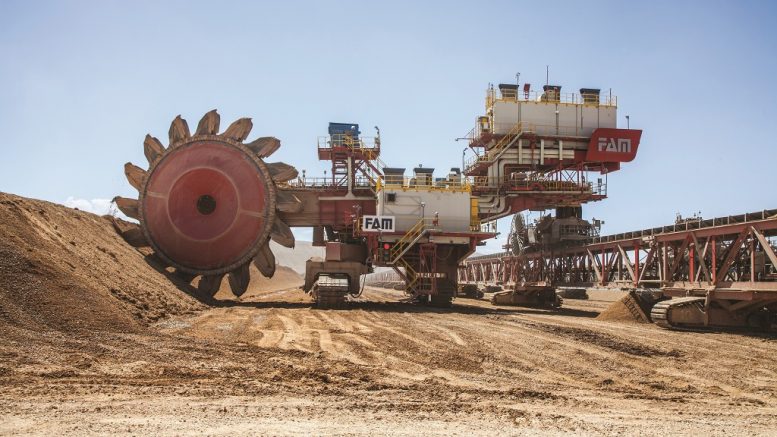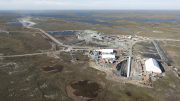The following is an edited release from the International Copper Study Group (ICSG) showing preliminary data for world copper supply and demand for February 2019. For more detailed information, visit www.icsg.org.
Preliminary data indicates that world copper mine production declined 1.8% in the first two months of 2019, with concentrate production declining 1.3% and solvent extraction-electrowinning, 4%.
Although a few countries experienced growth, this was largely offset by declines in two major copper producing countries, namely Chile and Indonesia.
Production in Chile, the world’s biggest copper-mine-producing country, declined 6%, mainly due to lower copper head grades.
Indonesian concentrate production declined 50%, primarily as a consequence of the transition of the country’s major two mines to different ore zones leading to temporarily reduced output levels.
After aggregated 13% growth in 2018, production in the Democratic Republic of the Congo (DRC) and Zambia increased 1.3% in the first two months of 2019, as reduced production at some mines partly offset ramp-up output at other operations.
Production in Peru (the world’s second-largest, copper-mine-producing country), Australia, China and Mongolia increased due to improved grades and recovery from constrained output in 2018.
On a regional basis, mine production increased an estimated 2% in Africa, 1% in North America and 5% in Oceania, but declined 3% in Asia, 4% in Latin America and 3% in Europe.
Refined production
Preliminary data indicates that world refined production stayed nearly the same in the first two months of 2019, with primary production (electrolytic and electrowinning) declining 0.6%, and secondary production (from scrap) increasing 0.3%.
The main contributor to the growth in world-refined production was China, due to the continued expansion of Chinese capacity.
Other countries recovering from production constraints in 2018 — such as Australia, Brazil and Poland — also contributed to growth.
However, overall growth was partly offset by a 15% decline in Chilean output, which mainly owed to temporary smelter shutdowns whilst undergoing upgrades to comply with new environmental regulations.
Production in India continued to be negatively impacted by the shutdown of Vedanta’s Tuticorin smelter, and declined 45%.
Aggregated refined production in the DRC and Zambia declined 7%.
On a regional basis, refined output increased in Asia (2%) and in Oceania (25%), while declining in Africa (-8%), in the Americas (-8%) and staying almost the same in Europe.
Preliminary data indicates that world apparent refined usage was about the same in the first two months of 2019.
Chinese apparent usage grew 4%, driven by a 2.5% increase in net refined copper imports.
Among other major copper users, demand increased in India, but declined in Japan, the EU and the United States. World ex-China usage declined 4%.
Copper balance
Preliminary world refined copper balance in the first two months of 2019 indicates a small surplus of 40,000 tonnes.
In developing its global market balance, ICSG uses an apparent demand calculation for China that does not take into account changes in unreported stocks [State Reserve Bureau, producer, consumer, merchant/trader, bonded].
To facilitate global market analysis, however, another line item — Refined World Balance Adjusted for Chinese Bonded Stock Changes — is included in the attached table that adjusts the world refined copper balance based on an average estimate of changes in unreported inventories, provided by three consultants with expertise in China’s copper market.
In the first two months of 2019, the world refined copper balance adjusted for changes in Chinese bonded stocks indicated a 125,000-tonne market surplus.
Copper prices, stocks
Based on the average of stock estimates provided by independent consultants, China’s bonded stocks are thought to have increased 85,000 tonnes in the first two months of 2019, compared to the year-end 2018 level. Bonded stocks decreased 3,000 tonnes in the same period of 2018.
As of the end of April, copper stocks held at the major metal exchanges (LME, COMEX, SHFE) totalled 476,720 tonnes — an increase of 126,224 tonnes (+36%) from stocks held at the end of December 2018. Stocks were down at COMEX (-69%) and up at SHFE (+85%) and the LME (+71%).
The average LME cash price for April 2019 was US$6,445.10 per tonne, down 0.1% from the March average of US$6,451.02 per tonne.
The 2019 high and low copper prices through the end of April were US$6,572 per tonne (on March 1) and US$5,811 per tonne (on Jan. 3), and the year average was US$6,270.39 per tonne (3.9% below the 2018 annual average).






Be the first to comment on "Facts ‘n’ Figures: World copper mine production falls 1.8% in early 2019, ICSG says"